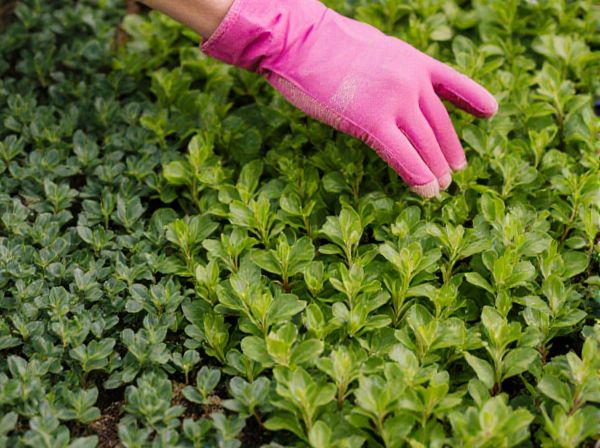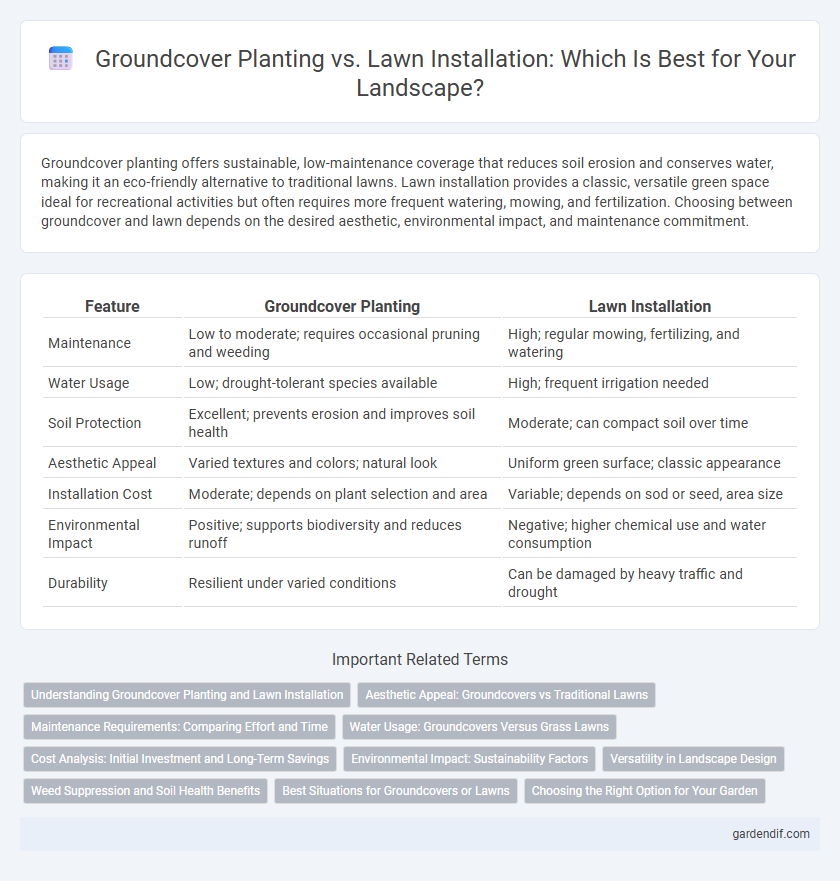
Groundcover Planting vs Lawn Installation Illustration
Groundcover planting offers sustainable, low-maintenance coverage that reduces soil erosion and conserves water, making it an eco-friendly alternative to traditional lawns. Lawn installation provides a classic, versatile green space ideal for recreational activities but often requires more frequent watering, mowing, and fertilization. Choosing between groundcover and lawn depends on the desired aesthetic, environmental impact, and maintenance commitment.
Table of Comparison
| Feature | Groundcover Planting | Lawn Installation |
|---|---|---|
| Maintenance | Low to moderate; requires occasional pruning and weeding | High; regular mowing, fertilizing, and watering |
| Water Usage | Low; drought-tolerant species available | High; frequent irrigation needed |
| Soil Protection | Excellent; prevents erosion and improves soil health | Moderate; can compact soil over time |
| Aesthetic Appeal | Varied textures and colors; natural look | Uniform green surface; classic appearance |
| Installation Cost | Moderate; depends on plant selection and area | Variable; depends on sod or seed, area size |
| Environmental Impact | Positive; supports biodiversity and reduces runoff | Negative; higher chemical use and water consumption |
| Durability | Resilient under varied conditions | Can be damaged by heavy traffic and drought |
Understanding Groundcover Planting and Lawn Installation
Groundcover planting involves using low-growing, spreading plants such as creeping thyme, sedum, or vinca to create a dense, weed-resistant surface that requires minimal maintenance and conserves water. Lawn installation typically consists of turfgrass species like Kentucky bluegrass, fescue, or Bermuda grass, offering a lush, uniform appearance but demanding regular mowing, irrigation, and fertilization. Selecting between groundcover and lawn depends on factors such as soil type, climate conditions, intended use, and maintenance capacity.
Aesthetic Appeal: Groundcovers vs Traditional Lawns
Groundcover planting offers a diverse palette of textures, colors, and seasonal interest that enhance the visual complexity of landscapes compared to the uniform appearance of traditional lawns. Groundcovers such as creeping thyme, sedum, and ajuga provide vibrant blooms and varied foliage, creating dynamic and sustainable aesthetic appeal. Lawns primarily offer a consistent green carpet but lack the rich biodiversity and intricate design possibilities inherent in groundcover installations.
Maintenance Requirements: Comparing Effort and Time
Groundcover planting typically demands less frequent watering, mowing, and fertilizing compared to lawn installation, significantly reducing overall maintenance time and effort. Groundcovers also suppress weeds naturally, minimizing the need for herbicide applications and manual weeding. Conversely, lawns require regular mowing, aeration, and consistent watering schedules to maintain healthy turf, resulting in higher ongoing labor and resource input.
Water Usage: Groundcovers Versus Grass Lawns
Groundcover planting typically requires significantly less water than traditional grass lawns, making it a more sustainable option for landscape water management. Many drought-tolerant groundcover species reduce irrigation needs by up to 50-70% compared to conventional turfgrass varieties. Selecting native or adapted groundcovers can further enhance water conservation while maintaining soil health and reducing runoff.
Cost Analysis: Initial Investment and Long-Term Savings
Groundcover planting generally requires a lower initial investment than lawn installation due to reduced soil preparation and seeding expenses. Over time, groundcover offers significant savings by minimizing water usage, mowing, fertilization, and pest control costs typically associated with lawns. Choosing drought-resistant groundcovers can further decrease maintenance efforts and energy consumption, optimizing long-term landscape management budgets.
Environmental Impact: Sustainability Factors
Groundcover planting enhances soil stability, reduces water usage, and supports biodiversity by providing habitat for pollinators, making it a more sustainable option than traditional lawn installation. Lawns typically require higher water consumption, frequent mowing, and chemical treatments, which contribute to increased carbon emissions and environmental degradation. Choosing native groundcover plants promotes a resilient ecosystem and lowers the carbon footprint associated with landscaping maintenance.
Versatility in Landscape Design
Groundcover planting offers greater versatility in landscape design by providing diverse textures, colors, and growth habits that adapt to various soil conditions and slopes. Unlike traditional lawns, groundcovers require less maintenance, reduce erosion, and support biodiversity, making them ideal for multifunctional outdoor spaces. Incorporating groundcovers alongside or instead of lawns enhances aesthetic appeal and environmental sustainability in both residential and commercial landscapes.
Weed Suppression and Soil Health Benefits
Groundcover planting offers superior weed suppression by creating dense, low-growing mats that outcompete weeds for sunlight and nutrients, reducing the need for chemical herbicides. Unlike traditional lawns, groundcovers improve soil health by enhancing organic matter, promoting beneficial microbial activity, and preventing erosion through extensive root systems. This sustainable approach supports long-term soil fertility and minimizes maintenance compared to frequent mowing and reseeding typical of lawn installation.
Best Situations for Groundcovers or Lawns
Groundcover planting excels in erosion control, low-maintenance landscapes, and shaded areas where grass struggles to thrive, providing dense, spreading foliage that suppresses weeds and conserves soil moisture. Lawns are ideal for high-traffic recreational spaces, formal garden designs, and sunny environments requiring resilient, uniform turf for aesthetic appeal and usability. Selecting groundcovers or lawns depends on site conditions, intended use, and maintenance capacity to optimize landscape performance and environmental benefits.
Choosing the Right Option for Your Garden
Groundcover planting offers low-maintenance, erosion control, and biodiversity benefits, making it ideal for slopes and shaded areas, whereas lawn installation provides a traditional aesthetic with recreational space but demands frequent mowing and watering. Selecting between groundcover and lawn depends on soil quality, sunlight exposure, garden size, and intended use, ensuring optimal plant health and sustainability. Evaluate local climate conditions and maintenance capacity to choose the most practical and visually pleasing option for your landscape design.
Groundcover Planting vs Lawn Installation Infographic

 gardendif.com
gardendif.com